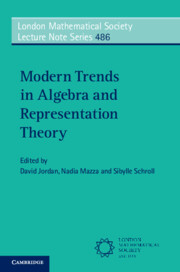Book contents
- Frontmatter
- Contents
- Contributors
- Preface
- Introduction
- 1 Auslander–Reiten Theory of Finite-Dimensional Algebras
- 2 τ-tilting Theory – an Introduction
- 3 From Frieze Patterns to Cluster Categories
- 4 Infinite-dimensional Representations of Algebras
- 5 The Springer Correspondence
- 6 An Introduction to Diagrammatic Soergel Bimodules
- 7 A Companion to Quantum Groups
- 8 Infinite-dimensional Lie Algebras and Their Multivariable Generalizations
- 9 An Introduction to Crowns in Finite Groups
- 10 An Introduction to Totally Disconnected Locally Compact Groups and Their Finiteness Conditions
- 11 Locally Analytic Representations of p-adic Groups
- References
6 - An Introduction to Diagrammatic Soergel Bimodules
Published online by Cambridge University Press: 25 November 2023
- Frontmatter
- Contents
- Contributors
- Preface
- Introduction
- 1 Auslander–Reiten Theory of Finite-Dimensional Algebras
- 2 τ-tilting Theory – an Introduction
- 3 From Frieze Patterns to Cluster Categories
- 4 Infinite-dimensional Representations of Algebras
- 5 The Springer Correspondence
- 6 An Introduction to Diagrammatic Soergel Bimodules
- 7 A Companion to Quantum Groups
- 8 Infinite-dimensional Lie Algebras and Their Multivariable Generalizations
- 9 An Introduction to Crowns in Finite Groups
- 10 An Introduction to Totally Disconnected Locally Compact Groups and Their Finiteness Conditions
- 11 Locally Analytic Representations of p-adic Groups
- References
Summary
This chapter is a survey of the category of diagrammatic Soergel bimodules and the main results about these representations.
Information
- Type
- Chapter
- Information
- Modern Trends in Algebra and Representation Theory , pp. 212 - 226Publisher: Cambridge University PressPrint publication year: 2023
